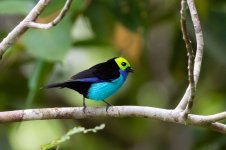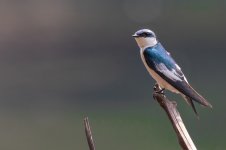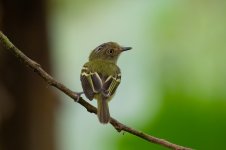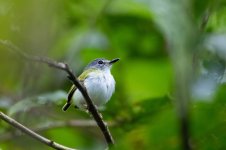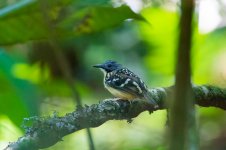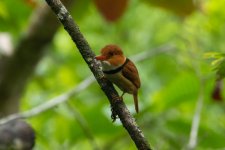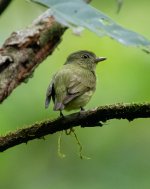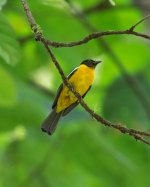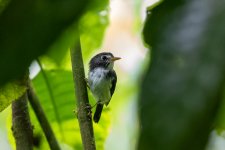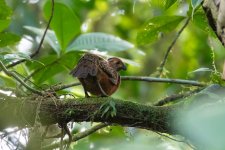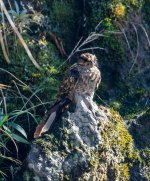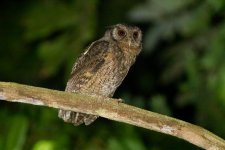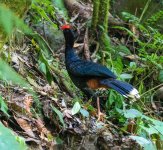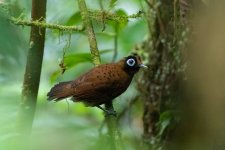Paujil 1
Let's begin with logistics. The station at Paujil is a big two storey wooden house, with a kitchen, flushing toilets and showers (though most people prefer to bathe in the quebrada below, which is heavenly after a day in the forest). There's electricty all day long thanks to solar panels. There are several rooms with beds plus a couple large rooms to set up tents if necessary.
However, you will need to bring all your food, soap, toilet paper, and a sleeping bag or your own sheets.
As for the birds, you can easily spend half a day without setting foot on the trails, as there are a good number of birds that hang out in the trees right around the clearing where the house was built. Large groups of Paradise (pic 1) and Green-and-Gold Tanagers flit around in the canopy, accompanied by the smaller Purple (pic 2) and Short-billed Honeycreepers (the latter being the less common of the two). At times Masked Tanagers can be abundant, while they seem to disappear in other seasons. Orange-bellied Euphonias often come down in the lower shrubs when they bear fruit, along with the less common Thick-billed Euphonia, Rufous-Bellied or even Golden-bellied Euphonia if you're lucky.
Silver-beaked, Blue-gray and Palm Tanagers are always in evidence, sometimes even perching on the roof of the kitchen, and both Social and Gray-capped Flycatchers nest by the station, while Yellow-browed Sparrows forage in the grass.
Mixed flock birds that often come by the edges of the clearing include Red-stained Woodpecker, Lafresnaye's Piculet, Black-capped Becard, Gray Elaenia, Green Honeycreeper, Blue and Black-faced Dacnis, Yellow-bellied Tanager or Bay-headed Tanager. There is also a Bright-rumped Attila that regularly sings nearby, but I never managed to lay eyes on the damn thing.
Keep an eye overhead for King Vultures and Plumbeous Kites, and there is a pair of Orange-breasted Falcons that can sometimes be seen by the cliff that overlooks the station.
Finally, one of my personal favorites, the Western Striolated-Puffbird (pic 3), a pair of which can often be seen in the large tree right by the kitchen (make sure to learn their characteristic double whistle, and they reply readily to playback).
If you walk down the steps to the river, you will likely find some Black Phoebes by the water, along with White-banded and White-winged Swallows (pic 4) on likely perches. Fasciated Tiger Herons often perch in the rocks and Drab Water Tyrants can occasionally be seen nearby, while Gray-rumped Swifts come by and hawk over the water in the evenings.
If you can, arrange for a ranger to take you across the quebrada Paujil in their little boat, as some of the best and easiest birding can actually be done on the trail that loops through the secondary forest past the rangers' houses (do be sure to clear it with them). You should have no trouble spotting Violaceous Jays, Yellow-rumped Caciques, Crested and Casqued Oropendolas in the trees by the chacras (keep an eye out for the occasional Olive Oropendola accompanying them), while Blue-headed Parrots constantly fly overhead.
Walking quietly on the trails, you've got a good chance of spotting a Gray-fronted Dove, a Ruddy Quail-Dove or even a Sapphire Quail Dove walking ahead of you, with the occasional White-throated Tinamou (pic 5) if you're lucky.
Paujil is not a particularly great place for hummingbirds (besides the ever common Fork-tailed Woodnymph), but what you will see often are hermits zooming by and occasionally hovering for an instant to check you out, mainly Great-billed and Black-throated Hermits.
Flocks in the forest interior will likely contain at least one of the common antshrikes : Mouse-colored, Plain-winged, and Dusky-throated Antshrikes. Those are usually accompanied by Gray and Long-winged Antwrens, and the occasional pair of Pygmy Antwrens. Other flock members are likely to include things like Carmiol's Tanager (very, very common here) Speckled Spinetail, Wedge-billed and Elegant Woodcreepers, Whiskered Flycatchers, Lemon-chested and Tawny-crowned Greenlets. You will hear the latter's whistle constantly but for some reason they are frustrfatingly hard to see, let alone photograph - the origin for the genus name Tunchiornis, which references the Tunchi, a mythical bird of bad omen that is heard at night but never seen (from imitations I've heard, I suspect it's a Pheasant Cuckoo).
A great place to stop for a while is the quebrada that runs just below Abelino's house. I've had Piratic Flycatcher, Crowned Slaty Flycatcher (summer months only), Crimson-Crested Woodpecker, Turquoise Tanager, Sepia-capped Flycatcher Double-banded Pygmy-Tyrant (pic 6), Short-crested Flycatcher, and Plain-Brown Woodcreeper right there. Through the constant din of bird vocalizations, keep your ears attuned to the insect-like buzz of the Short-tailed Pygmy-Tyrant (pic 7), a delightful fluffball of a bird, and the smallest passerine in the world!
As you step back into the forest, keep an ear out for the pretty White-shouldered Antshrike, which is usually much more shy than its relatives. Black Antbird is a common voice in shrubby vegetation along the edges and responds readily to playback. The most common true antbird is definitely Black-faced Antbird, and it shouldn't be a great challenge to see this rotund bird. Some areas along the main path where it follows the river, with a rather open understorey, are a good spot to look for the beautiful Spot-backed Antbird (pic 8). White-chested Puffbird isn't uncommon, but I only ever saw them through luck, either when I startled one by the path, or when I happened to spot one swooping for a prey. I also once startled a roosting Spectacled Owl in that same area.
The path is only a few kilometers long but it can easily keep you occupied all day. If you are coming back around sundown, you may run into Green Ibises foraging in the mud near one of the houses, while Plumbeous Kites hunt overhead, looking like nighthawks!
I'll leave the primary forest for the next post!




